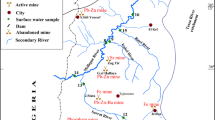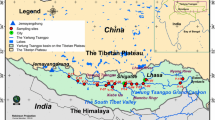Abstract
Water samples were collected from 10 locations along the Truckee River system, 14 locations along the Walker River system, and 12 locations along the Carson River, and analyzed for B, Mo, V, W, Na, Cl, and pH. Boron concentrations ranged from approximately 2 μmol/kg in the upper reaches of the Truckee River to almost 1,200 μmol/kg in Pyramid Lake. Molybdenum, V, and W had concentrations in the nanomolal range; Mo varied from a low of about 12 nmol/kg to a high of 3,200 nmol/kg (Walker Lake); V ranged from 9 nmol/kg to approximately 470 nmol/kg; and W varied from a low value around 0.8 nmol/kg (West Walker River) to 1,030 nmol/kg. The high concentrations of these oxyanion-forming trace elements in the rivers reflects (1) the relative stability of these oxyanions (e.g., MoO4 2-, HVO4 2-, WO4 2-, B(OH)3, and/or B(OH)4 -) in the alkaline, well oxygenated river and lake waters, (2) contributions of hydrothermal waters (especially for B), and (3) weathering of rocks/regolith with high concentrations of these elements. In the case of Mo, V, and W, each exhibited relatively conservative behavior in the upper, oxygenated reaches of all three rivers. During the study period the region experienced a prolonged drought such that the lower reaches of each river were typified by no flow or stagnant waters and probably low oxygen and/or anoxic conditions (although not measured). Reductive processes occurring in the low flow to stagnant reaches of each river could have led to removal of Mo, V, and W from solution as coprecipitates with Fe monosulfides, or via sorption to Fe oxides/oxyhydroxides and/or organic matter. Boron, however, exhibited essentially no or minor removal from these rivers, and instead was added to each river via B-rich hydrothermal waters (e.g., Steamboat Creek from Steamboat Hot Springs), or by B-rich groundwaters via base-flow during the extensive drought.
Similar content being viewed by others
References
Allegre, C. J., Dupre, B., Negrel, P., and Gaillardet, J. (1996) Sr-Nd-Pb isotope systematics in Amazon and Congo River systems: Constraints about erosion processes. Chem.Geol. 131, 93–112.
Arnórsson, S. and Andrésdóttir, A. (1995) Processes controlling the distribution of boron and chlorine in natural waters in Iceland. Geochim.Cosmochim.Acta 59, 4125–4146.
Arnórsson, S., Gíslason, S. R., Gestsdóttir, K., and Óskarsson, N. (1989) Chlorine and boron in natural waters in Iceland. In Proceedings of the 6th International Symposium on Water-Rock Interaction, Malvern, England, pp. 37–40.
Benson, L. V. (1984) Hydrochemical data for the Truckee River drainage system.U.S.Geol.Surv.Open-File Rept. 84–0440.
Benson, L. V. and Leach, D. L. (1979) Uranium transport in the Walker River Basin, California and Nevada. J.Geochem.Explor. 11, 227–248.
Benson, L. V and Spencer, R. J. (1983) A hydrochemical reconnaissance of the Walker River basin, California and Nevada. U.S.Geol.Surv.Open-File Rept. 83–0740.
Bertine, K. K. (1972) The deposition of molybdenum in anoxic waters. Mar.Chem. 1, 43–53.
Bonham, H. F. (1969) Geology and mineral deposits ofWashoe and Storey Counties, Nevada. Nevada Bur.Mines and Geol., Bull. 70.
Brown, W. M., Nowlin, J. O., Smith L. H., and Flint, M. R. (1986) River-quality assessment of the Truckee and Carson River system, California and Nevada. U.S.Geol.Surv.Open-File Report 84–576.
Collier, R. W. (1984) Particulate and dissolved vanadium in the North Pacific Ocean. Nature 309, 441–444.
Collier, R. W. (1985) Molybdenum in the North Pacific Ocean. Limnol.Oceanogr. 30, 1351–1354.
Cutter, G. A. and San Diego-McGlone, M. C. L. (1990) Temporal variability of selenium fluxes in San Francisco Bay. Sci.Total Environ. 97/98, 235–250.
Domagalski, J. L., Eugster, H. P., and Jones, B. F. (1990) Trace metal geochemistry ofWalker,Mono, and Great Salt Lakes, In: R. J. Spencer and I.-M. Chou (eds.), Fluid-Mineral Interactions: A Tribute to H.P.Eugster. The Geochemical Society Spec. Publ. 2, 315–354.
Doyle, G. A. (1993) Selenium concentrations in eastern Sierra Nevada river systems. M. S. Thesis. University of Nevada, Reno, 67 pp.
Doyle, G. A., Lyons, W. B., Miller, G. C., and Donaldson, S. G. (1995) Oxyanion concentrations in eastern Sierra Nevada rivers-1. Selenium. Appl.Geochem. 10, 553–564.
Eakin, T. E., Price, D., and Harrill, J. (1976) Summary appraisals of the nation's groundwater resources-Great Basin region. U.S.Geol.Surv.Prof.Paper813-G.
Edmond, J. M., Palmer, M. R., Measures, C. I., Grant, B., and Stallard, R. F. (1995) The fluvial geochemistry and denudation rate of the Guayana Shield in Venezuela, Columbia, and Brazil. Geochim.Cosmochim.Acta 59, 3301–3325.
Elbaz-Poulichet, F., Nagy, A., and Cserny, T. (1997) The distribution of redox sensitive elements (U, As, Sb, V and Mo) along a river-wetland-lake system (Balaton Region, Hungary). Aquatic Geochem. 3, 267–282.
Ellis, A. J. and Sewell, J. R. (1963) Boron in rocks and waters of New Zealand hydrothermal areas. New Zealand J.Sci.6, 589–606.
Ellis, A. J. and Mahon, W. A. J. (1966) Geochemistry of the Ngawha hydrothermal area.New Zealand J.Sci. 9, 440–456.
Emerson, S. R. and Huested, S. S. (1991) Ocean anoxia and the concentrations of molybdenum and vanadium in seawater. Mar.Chem. 34, 177–196.
Emett, D. C., Hutchinson, D. D., Jonson, N. A., and O'Hair, K. L. (1994)Water resource data Nevada water year 1993. U.S.Geol.Surv.Water Data Rept.NV–93–1.
Eugster, H. P. and Hardie, L. A. (1978) Saline lakes, in: A. Lerman (ed.)Lakes-Chemistry, Geology, Physics. Springer-Verlag, New York, pp. 237–293.
Gaillardet, J., Dupre, B., Allegre, C. J., and Negrel, P. (1997) Chemical and physical denudation in the Amazon River Basin. Chem.Geol. 142, 141–173.
Galat, D. L. (1990) Seasonal and long-term trends in Truckee River nutrient concentration and loadings to Pyramid Lake, Nevada: a terminal saline lake. Water Res. 24, 1031–1040.
Galat, D. L. and Robinson, R. (1983) Predicted effects of increasing salinity on the crustacean zooplankton community of Pyramid Lake Nevada. Hydrobiologia 105, 115–131.
Galat, D. L., Lider, E. L., Vigg, S., and Robinson, R. (1981) Limnology of a large, deep, North American terminal lake, Pyramid Lake, Nevada. Hydrobiologia 82, 281–317.
Garcia, K. T., Gortsema, G. C., Pennington, R. N., and Preissler, A. M. (1992) Water resource data, Nevada, water year 1991. U.S.Geol.Surv.Water Data Rept. NV–91–1.
Garrels, R. M. and Mackenzie, F. T. (1967) Origin of chemical compositions of some springs and lakes. In R. F. Gould (ed.) Equilibrium Concepts in Natural Water Systems. Advances in Chemistry Series 67, American Chemical Society, Washington DC, pp. 222–242.
Garside, L. J. and Schilling, J. H. (1979) Thermal waters of Nevada.Nevada Bureau of Mines and Geology,Bull. 91, Mackay School of Mines, University of Nevada, Reno, NV.
Goodman, B. A. and Cheshire, M. V. (1975) The bonding of vanadium in complexes with humic acids: an electron paramagnetic resonance study. Geochim.Cosmochim.Acta 39, 1711–1713.
Harder, H. (1970) Boron content of sediments as a tool in facies analysis. Sediment.Geol. 4, 153–175.
Harding, S. T. (1935) Changes in lake levels in Great Basin Area. Civ.Eng. 5, 87–90.
Hess, D. L., Mello, K. A., Sexton, R. J., and Young, R. L. (1993)Water resources data, Nevada, water year 1992. U.S.Geol.Surv.Water Data Rept.NV–92–1.
Hem J. D. (1974) Reactions of metal ions at surfaces of hydrous iron oxide. Geochim.Cosmochim.Acta 41, 527–538.
Hingston, F. J., Atkinson, R. J., Posner, A. S., and Quirk, J. P. (1967) The specific adsorption of anions. Nature 215, 1459–1461.
Jeandel, C., Caisso, M., and Minster, J. F. (1987) Vanadium behaviour in the global ocean and in the Mediterranean Sea. Mar.Chem. 21, 51–74.
Johannesson, K. H., Lyons, W. B., Huey, S., Doyle, G. A., Swanson, E. E., and Hackett, E. (1997) Oxyanion concentrations is eastern Sierra Nevada rivers-2. Arsenic and phosphate.Aquatic Geochem. 3, 61–97.
Jones, B. F. (1966) Geochemical evolution of closed basin water in the western Great Basin.Proc. Second Symp.Salt, North Ohio Geol.Soc. 1, 181–200.
Kaback, D. S. and Runnells, D. D. (1980) Geochemistry of molybdenum in some stream sediments and waters. Geochim.Cosmochim.Acta 44, 447–456.
Koening, J. B. (1963) Geologic Map of California, Walker Lake Sheet.Calif.Div.Mines and Geol.
Korolov, D. F. (1958) The role of iron sulfides in the accumulation of molybdenum in sedimentary rocks of the reduced zone. Geochem.J. 4, 452–463.
Maest, A. S., Pasilis, S. P., Miller, L. G., and Nordstrom, D. K. (1992) Redox geochemistry of arsenic and iron in Mono Lake, California, USA. In: Y. Kharaka and A. S. Maest (eds.), Water-Rock InteractionBalkema, pp. 507–511.
McElligott, S. and Byrne, R. H. (1998) Interaction of B(OH)3 0 and HCO_ in seawater: Formation of B(OH)2CO3 _. Aquatic Geochem. 3, 345–356.
Moore, J. G. (1969) Geology and mineral deposits of Lyon, Douglas, and Ormsby Counties, Nevada. Nev.Bur.Mines and Geol., Bull. 75.
Nehring, N. L. (1980) Geochemistry of Steamboat Springs, Nevada. U.S.Geol.Surv.Open File Rep. 80–887.
Nimick, D. A. (1998) Arsenic hydrogeochemistry in an irrigated river valley-A re-evaluation. Ground Water 36, 743–753.
Nimick, D. A., Moore, J. N., Dalby, C. E., and Savka, M. W. (1998) The fate of geothermal arsenic in the Madison and Missouri Rivers, Montana and Wyoming. Water Resour.Res. 34, 3051–3067.
Peucker-Ehrenbrink, B. and Ravizza, G. (1996) Continental runoff of osmium into the Baltic Sea. Geology 24, 327–330.
Phillips, K. N. and Van Denburgh, A. S. (1971) Hydrology and geochemistry of Abert, Summer, and Goose Lakes, and other closed-basin lakes in south-central Oregon.U.S.Geol.Surv.Prof.Paper 502-B.
Seiler, R. L. (1996) Synthesis of data from studies by the National IrrigationWater-Quality Program. J.Am.Water Resour.Assoc. 32, 1233–1245.
Shiller, A. M. and Boyle, E. A. (1987) Dissolved vanadium in rivers and estuaries. Earth Planet.Sci. Lett.86, 214–224.
Sholkovitz, E. R. (1995) The aquatic chemistry of rare earth elements in rivers and estuaries.Aquatic Geochem. 1, 1–34.
Spencer, R. J. (1977) Silicate and carbonate sediment-water relationships in Walker Lake, Nevada, M. S. Thesis, University of Nevada, Reno.
Stewart, J. H. and Carlson, J. E. (1978) Geologic Map of Nevada. Nevada Bur.Mines and Geol.
van der Sloot, H. A., Hoede, D., Wijkstra, J., Duinker, J. C., and Nolting, R. F. (1985) Anionic species of V, As, Se, Mo, Sb, Te, andWin the Scheldt and Rhine estuaries and the Southern Bight (North Sea). Est.Coast Shelf Sci. 21, 633–651.
Vengosh, A. and Keren, R. (1996) Chemical modification of groundwater contaminated by recharge of treated sewage effluent. J.Contam.Hydrol. 23, 347–360.
Vengosh, A., Heumann, K. G., Juraske, S., and Kasher, R. (1994) Boron isotope application for tracing sources of contamination in groundwater. Environ.Sci.Technol. 28, 1968–1974.
Welch, A. H. and Lico, M. S. (1998) Factors controlling As and U in shallow groundwaters, southern Carson Desert, Nevada. Appl.Geochem. 13, 521–539.
Welch, A. H., Lico, M. S., and Hughes, J. L. (1988) Arsenic in ground water of the western United States. Ground Water 26, 333–347.
Welch, A. H., Plume, R. W., Frick, E. F., and Hughes, J. L. (1989) Ground-water-quality assessment of the Carson River Basin, Nevada and California: Analysis of available water-quality data through 1987. U.S.Geol.Surv.Open-File Rept. 89–382.
Welch, A. H., Lawrence, S. J., Lico, M. S., Thomas, J. M., and Schaefer, D. H. (1997) Ground-water quality assessment of the Carson River Basin, Nevada and California-Results of Investigations, 1987–91. U.S.Geol.Surv.Water-Supply Paper2356-A.
White, D. E. (1957) Magmatic, connate and metamorphic waters. Bull.Geol.Soc.Amer. 68, 1659–1682.
Willden, R. and Speed, R. C. (1974) Geology and mineral deposits of Churchill County, Nevada. Nev.Bur.Mines and Geol., Bull. 83.
Zang, J. (1996) Geochemistry of arsenic in the Huanghe (Yellow River) and its delta region-A review of available data. Aquatic Geochem. 1, 241–275.
Author information
Authors and Affiliations
Rights and permissions
About this article
Cite this article
Johannesson, K.H., Lyons, W.B., Graham, E.Y. et al. Oxyanion Concentrations in Eastern Sierra Nevada Rivers – 3. Boron, Molybdenum, Vanadium, and Tungsten. Aquatic Geochemistry 6, 19–46 (2000). https://doi.org/10.1023/A:1009622219482
Issue Date:
DOI: https://doi.org/10.1023/A:1009622219482




